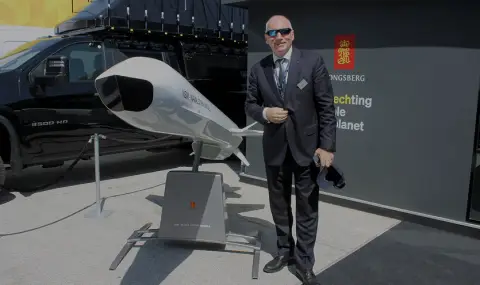And this year's 19th consecutive edition of "Hemus 2024" brought together the best companies in the defense industry worldwide. Against the background of two wars - Ukraine and Israel and the rapid introduction of artificial intelligence, defense, we can safely say that the defense industry is developing more than dynamically. However, what are the trends in the development of the defense industry and what are the biggest challenges for companies in the military-industrial sector? These questions are answered in a special interview for FACTS by Vidar Skelstad, vice president in the direction of strategic campaigns, integrated defense systems in Kongsberg.
Mr. Skelstad, how do you see the latest technologies and what are the development trends in the defense industry?
We have to go back a bit in time when we talk about the development of technology, namely somewhere in the 90s of the last century. If you look at the development of computers, of telephones, and what is happening in the defense industry, in the beginning, for each product, it was created its own software, written in assembly language, which ran under the management of its own operating system, which is very labor-intensive. Kongsberg realized that the future was in general purpose computers, so we bet on general purpose computers used in the civilian sector. We are the first company in the world to successfully implement a general purpose computer in the military industry. In the beginning, in the military industry we used specialized hardware and software, and when computers in the civilian sector developed enough we switched to general purpose computers that run universal operating systems.
The use of general purpose computers in the defense industry was something very innovative at the time, and now a new trend is coming. What is currently seen as a mega trend is the development of mega computers and artificial intelligence.
I can say about our systems that they are designed to be able to evolve continuously. When a new technology comes along, we start thinking about how to implement it in our systems. Today, a quantum computer is as big as a building. The trend was similar with the first computers. They were very large, but became smaller as time went on. Now we have enormous computing power even in a mobile phone.
Our vision is to make maximum use of modern technologies. The moment a given technology is developed and established enough, it is implemented in the military industry, in our products.
Example: This is a NASAM system simulator. The system was built in 1997. But what we had back then doesn't look like that. Back then, there were no touchscreens and many other things. Now there is. This is an example of technology development.
What are the biggest challenges facing military technology amid two wars – in Ukraine and Israel?
This is a challenge for everyone. The defense industry is extremely competitive, as the engine of development is the market. We are developing according to demand, intending to focus on mass production. But any setup still takes time, and the whole process is dictated by the demands of the market, which are numerous and rapidly changing.
Currently we have tripled the production of ammunition. We are optimizing the available capacity that we have. Double and triple shifts work on the production lines. When it is seen that the market wants more, we will expand and invest.
The problems are always on the side of the government, which has to make decisions and conclude contracts. Industry bears the risk, but cannot bear all the risk. Still, the government must bear some of the risk. What we are seeing at the moment is that governments are not so quick to make decisions and that is to some extent a hindrance. The whole industry is under very serious pressure. But we adapt. There are critical components that must be delivered in order not to stop processes.
You say the competition is great. What factors should the companies that will emerge victorious have?
Now I will tell you Kongsberg's secret. The company doesn't try to do everything. Kongsberg focuses on small niches. We are also here with a niche product. It's the same idea that comes from the time of the Vikings when they only had two weapons – the ax and the shield.
Today, 100 years later, the ax is the NSM missile and the shield is the NASAMS air defense system. Things haven't changed at all, only the devices change.

